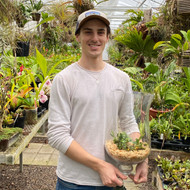Exploring “Cool” Terrarium Plants
Posted by Adam Kostanecki on Jan 11th 2021

Hi there! My name is Adam Kostanecki. I’ve recently joined the team at Orchids Limited and I couldn’t be more excited about what’s ahead for us. A little bit about me: I studied Plant and Microbial Biology at the University of Minnesota (Go Gophers!) and deepened my interest in plants while working at the College of Biological Sciences Conservatory, as well as in three research laboratories. In recent months, I reached out to Jason and we instantly clicked over our mutual passion for all things plants. As Orchid Limited’s newest Greenhouse Manager, I’ll be handling a great assortment of responsibilities, including writing blogs such as this one! I’m looking forward to meeting and interacting with many of you in the near future - and now, on to the blog!
– – –
With the start of the new year, we’re all looking for ways to “turn a new leaf”. Some do so figuratively, while others (like you and me), might do exactly that - turn a new leaf in the most literal sense.

Odds are, when someone mentions the word ‘terrarium,’ you picture a well-misted glass enclosure featuring the typical cast: perhaps philodendrons are cascading down on stage right, with a few bromeliads and ferns playing supporting roles in the background, but these are typical terrarium residents, and diversity is the spice of life! For that reason, I’d like to spice up the options when it comes to terrarium plants - specifically cool temperature terrarium plants.

Example terrarium including Masdevallia nidifica alba (left), Mediocalcar decoratum (center), and Porroglossum dalstroemii (right).
Plants that fall into this category typically come from high altitude cloud forests, where they grow as epiphytes (plants that grow on other plants non-parasitically). For our purposes, we’ll want plants with a preference for filtered light and high humidity. Taking these points into consideration, I’d recommend a fantastic orchid, Mediocalcar decoratum! This miniature New Guinea-native has a mat-forming habit, producing purple-tinted cylindrical pseudobulbs displaying thick, deep-green leaves. In spring, M. decoratum produces a flurry of yellow-orange flowers that hang like tiny lanterns throughout the mat, lasting up to two months. Take care to use reverse-osmosis water when the moss is nearly dry, and this orchid should quickly grow into a size that will delight any terrarium grower. With its diminutive nature and fun flowers, this is a plant that easily brings a smile to my face.

Aside from this spotlight, there are several other orchids that I’d like to mention for those of you interested in a wider selection of cool temperature terrarium plants we have to offer:

Dryadella simula - lovely miniature clumps of compact, glossy leaves, producing yellow flowers dotted in delicate purple spots. These divisions came from an award-winning specimen!
Masdevallia nidifica - cute, compact and easy to grow! Blooms in the summer and fall, showing off beautiful tiny purple or white flowers (both color choices available).
Ornithophora (Sigmatostalix) radicans - these bright green pseudobulbs will pop amidst other darker-green growers. Their color and larger relative size makes them a good option as the centerpiece in your terrarium. Plus, you get to enjoy the scent of honey emitting from its flowers in the spring and fall.

Pleurothallis truncata - an excellent choice for a larger terrarium plant, this orchid grows 6" long stems ending in 3" spade-shaped leaves and produces beautiful orange, spherical flowers in the winter.
Pleurothallis restrepioides - looking for multi-flowering spikes of pendulant, purple-speckled white flowers? This easy-to-grow orchid with upright paddle-shaped leaves is sure to impress!
Porroglossum dalstroemii - if you’re missing an interactive orchid from your collection, perhaps this miniature is the one for you! The flower lip of this genus snaps shut when triggered by a landing pollinator (or yourself). Not only that, but some leaves display purple netted venation as well.
Porroglossum muscosum - another trigger-lipped option, the leaves of this miniature orchid have a textured surface and color that varies from deep green to bronze. The purple and gold flowers of this species stand atop bright green pipe-cleaner-like spikes.

Restrepia dodsonii - intermediate sized, yet compact, the flowers of this orchid spike from each leaf throughout the year. Moderate fertilizing and high humidity will lead to fast growth with this one!
Stelis major - enjoy several simultaneous spikes displaying miniature peach-colored flowers throughout the year with this uncommon, yet cute, addition to your collection.
Stelis species - a unique member of our collection that produces deep purple flowers which, and here’s the kicker, don’t open! Whether or not it’s a mutation, this is a peculiar plant with limited stock.
A few quick tips: If you’re in need of the starting supplies for your terrarium, you can find an assortment of glass containers at your local home goods store. Additionally, it’s good practice to place an inorganic layer on the bottom (such as charcoal, clay pebbles, or lava rock) of your terrarium setup in order to avoid leaving the plant roots sitting in water. When it comes to watering, it’s best practice to use reverse-osmosis water when possible. While you can stock up on distilled water from the store, a great at-home source is your very own dehumidifier!

Finally, for those of you looking to take your terrarium growing to the next level, I recommend considering our Orchidarium. These high-quality cases are designed to maintain the humidity levels needed to grow your miniature orchids to the best they can be. Pair this with a set of cool LED lights, fogger, hygrometer and timer to create an all-in-one system that will grow your collection into an impressive at-home cloud forest display.
Among the eleven plants listed above, I’m sure you will find something that suits what you’re looking for. I hope you enjoy the creative terrarium-making process, and feel free to send in photos of your creations! We’d love to see what you all end up putting together.
Cheers!
Adam Kostanecki

